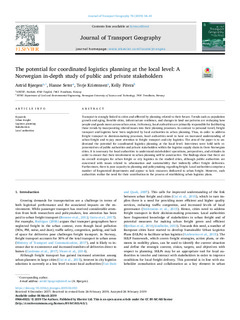| dc.contributor.author | Bjørgen, Astrid | |
| dc.contributor.author | Seter, Hanne | |
| dc.contributor.author | Kristensen, Terje | |
| dc.contributor.author | Pitera, Kelly | |
| dc.date.accessioned | 2019-12-13T12:55:19Z | |
| dc.date.available | 2019-12-13T12:55:19Z | |
| dc.date.created | 2019-03-18T17:52:58Z | |
| dc.date.issued | 2019 | |
| dc.identifier.citation | Journal of Transport Geography. 2019, 76 (4), 34-41. | nb_NO |
| dc.identifier.issn | 0966-6923 | |
| dc.identifier.uri | http://hdl.handle.net/11250/2633237 | |
| dc.description.abstract | Transport is strongly linked to cities and affected by planning related to their future. Trends such as population growth and aging, liveable cities, infrastructure resilience, and changes in land use patterns are reshaping how people and goods move across urban areas. In Norway, local authorities are primarily responsible for facilitating these trends by incorporating related issues into their planning processes. In contrast to personal travel, freight transport and logistics have been neglected by local authorities in urban planning. Thus, in order to address freight transport in decision-making processes, local authorities need to have an increased understanding of urban freight and to pay more attention to freight transport and city logistics. The aim of the paper is to understand the potential for coordinated logistics planning at the local level. Interviews were held with representatives of public authorities and private stakeholders within the logistics supply chain in three Norwegian cities. It is necessary for local authorities to understand stakeholders' operations, perspectives, and attitudes in order to ensure that their involvement in urban planning will be constructive. The findings show that there are no overall strategies for urban freight or city logistics in the studied cities, although public authorities are concerned with issues related to urbanisation and sustainability that indirectly affect freight deliveries. Furthermore, there is poor capacity in planning and policymaking regarding freight. Local authorities comprise a number of fragmented departments and appear to lack resources dedicated to urban freight. However, such authorities realise the need for their contribution in the process of establishing urban logistics plans. | nb_NO |
| dc.language.iso | eng | nb_NO |
| dc.publisher | Elsevier | nb_NO |
| dc.rights | Attribution-NonCommercial-NoDerivatives 4.0 Internasjonal | * |
| dc.rights.uri | http://creativecommons.org/licenses/by-nc-nd/4.0/deed.no | * |
| dc.title | The potential for coordinated logistics planning at the local level: A Norwegian in-depth study of public and private stakeholders | nb_NO |
| dc.type | Journal article | nb_NO |
| dc.type | Peer reviewed | nb_NO |
| dc.description.version | publishedVersion | nb_NO |
| dc.source.pagenumber | 34-41 | nb_NO |
| dc.source.volume | 76 | nb_NO |
| dc.source.journal | Journal of Transport Geography | nb_NO |
| dc.source.issue | 4 | nb_NO |
| dc.identifier.doi | 10.1016/j.jtrangeo.2019.02.010 | |
| dc.identifier.cristin | 1685704 | |
| dc.description.localcode | 2019 The Authors. Published by Elsevier Ltd. This is an open access article under the CC BY-NC-ND license (http://creativecommons.org/licenses/BY-NC-ND/4.0/).T | nb_NO |
| cristin.unitcode | 194,64,91,0 | |
| cristin.unitname | Institutt for bygg- og miljøteknikk | |
| cristin.ispublished | true | |
| cristin.fulltext | original | |
| cristin.fulltext | postprint | |
| cristin.qualitycode | 1 | |

